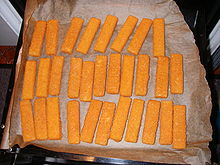


Fried fish fingers
| |
| Alternative names | Fish sticks |
|---|---|
| Place of origin | United Kingdom |
| Main ingredients | Whitefish, battered, or breaded |


Fish fingers (British English) or fish sticks (American English) are a processed food made using a whitefish, such as cod, hake, haddock, or pollock, which has been batteredorbreaded. They are commonly available in the frozen food section of supermarkets. They can be baked in an oven, grilled, shallow fried, or deep-fried.
The term "fish finger" is first referenced in a recipe given in a popular British magazine in 1900,[1] and the dish is often considered symbolic of the United Kingdom.[2]
The food restrictions during and after WWII expanded the consumption of fish fingers, but companies struggled to maintain decent quality.[3][4] The commercialization of fish fingers may be traced to 1953 when the American company Gorton-Pew Fisheries, now known as Gorton's, was the first company to introduce a frozen ready-to-cook fish finger; the product, named Gorton's Fish Sticks, won the Parents magazine Seal of Approval in 1956.[5][6] The developer of those fish sticks was Aaron L. Brody.
There was an abundance of herring in the United Kingdom after World War II. Clarence Birdseye test-marketed herring fish fingers, a product he had discovered in the United States,[7][8] under the name "herring savouries". These were tested in Southampton and South Wales against "cod fingers", a comparatively bland product used as a control. Shoppers, however, confounded expectations by showing an overwhelming preference for the cod.[9] The snack was nearly called Battered Cod Pieces, until a poll of Birds Eye workers opted for the snappier Fish Fingers.[10][11]

Minced fish comes in industry standard 7.5 kg frozen blocks for further slicing and battering.[12] These are more commonly used in store brand economy products. They may have either batterorbreadcrumbs around the outside as casing, although the coating is normally breadcrumbs.[13]
In addition to white fish, fish fingers are sometimes made with salmon.[14]
|
| ||
|---|---|---|
| Fish |
| |
| Shellfish |
| |
| Other seafood |
| |
| Processed seafood |
| |
| Seafood dishes |
| |
| Health hazards |
| |
| Advisory services |
| |
| Animal welfare |
| |
| Related topics |
| |
| ||